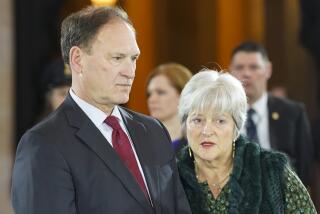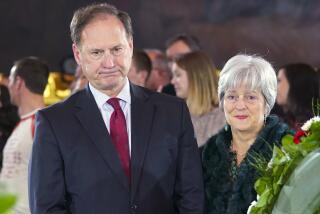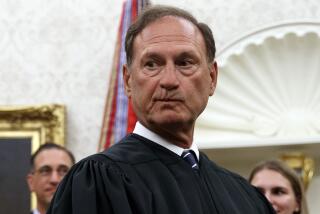Bias, Candor Again Issues as Rehnquist Faces Senate
- Share via
WASHINGTON — Nearly 15 years after he was named to the Supreme Court, Justice William H. Rehnquist faces renewed scrutiny today from the Senate Judiciary Committee on his role in two racially charged disputes as the panel determines whether he should be confirmed as chief justice.
And, central to both disputes is whether Rehnquist misled senators during his 1971 confirmation process when answering questions about the events, which occurred more than a quarter-century ago.
The first of the issues involves a legal memo defending segregation that he wrote as a law clerk to Justice Robert H. Jackson in 1952; the other involves his role in a vigorous challenge to minority voters in Phoenix in the early 1960s.
But underlying these issues is a third one, for which his Democratic foes have had trouble mustering support: whether Rehnquist--as the justice farthest out on the conservative ideological pole--has taken himself out of the “mainstream” of judicial thought, making him unfit to serve as chief justice.
About 45 witnesses, most of them opponents, have asked to testify after Rehnquist undergoes questioning today. However, a favorable committee recommendation and Senate confirmation in September now appear certain.
Nevertheless, Joseph L. Rauh Jr., counsel for the Leadership Conference on Civil Rights and a vociferous critic at Rehnquist’s 1971 hearings, said Monday: “Don’t count us out yet . . . . His whole life pattern shows he doesn’t believe in individual rights. I think the Senate is going to wake up to this and I think he’s going to be defeated.”
In the typewritten 1952 memo to Jackson, Rehnquist concluded: “I realize that it is an unpopular and unhumanitarian position, for which I have been excoriated by ‘liberal’ colleagues, but I think Plessy vs. Ferguson (the 1898 Supreme Court decision that the Constitution permitted segregated facilities) was right and should be reaffirmed.”
The memorandum came to light in 1971 after Rehnquist’s Judiciary Committee hearings but before the Senate voted on his confirmation. The disclosure so damaged his prospects that it prompted him to write former Sen. James O. Eastland (D-Miss.), then chairman of the committee, to offer an explanation.
In the letter to Eastland, Rehnquist wrote: “I believe that the memorandum was prepared by me as a statement of Justice Jackson’s tentative views for his own use at conference (of the justices).” Jackson died in 1954.
Explanation in Doubt
However, the issue has been rekindled recently as doubts have been cast on Rehnquist’s explanation by legal scholars and Elsie Douglas, Jackson’s secretary at the time of the memo.
Douglas, who dismissed Rehnquist’s explanation as “incredible on its face,” said that he had “smeared the reputation of a great justice.” However, she said Monday that she is going on vacation and will not testify at Rehnquist’s hearing.
Other doubts were raised by Dennis J. Hutchinson, a University of Chicago law professor who is writing a biography of Jackson, although he also has not been asked to testify and does not plan to volunteer. In an interview, however, Hutchinson said that, based on circumstantial evidence such as style and tone, “I would say it’s much more likely that these were the thoughts of Rehnquist and not Jackson.”
Moreover, similar thoughts were conveyed in other Rehnquist memos written about the same time and found among Jackson’s papers.
Suit by Black Voters
One was written in opposition to an appeal by black voters in Fort Bend, Tex., who contended that they were unconstitutionally shut out of Democratic primaries by a private Democratic club that admitted only whites and exercised great influence through its endorsements.
In the memo, he wrote: “It is about time the Court faced the fact that the white people on (sic) the South don’t like the colored people; the Constitution restrains them from effecting this dislike thru state action, but it most assurely (sic) did not appoint the Court as a sociological watchdog to rear up every time private discrimination raises its admittedly ugly head.”
Jackson, who joined the court with the reputation of a staunch New Dealer, proved to be slightly right of center. Although regarded as among the court’s most brilliant writers, he never was the predictable or consistent ideologue that Rehnquist has been.
The other topic on which Rehnquist is sure to face questioning this week is the Phoenix voting issue, which involved challenges to minority voters in the 1962 and 1964 elections by Republicans at polling places in Maricopa County--challenges that some witnesses contended Rehnquist took part in and which, critics charge, amounted to harassment and intimidation.
Rehnquist, who acknowledged serving in 1964 as county chairman of the GOP’s ballot security program, said in a letter included in the 1971 hearings: “In none of these years did I personally engage in challenging the qualifications of any voters.”
Stand Challenged
However, the issue has resurfaced because several new witnesses have come forward to challenge Rehnquist’s version.
Charles W. Pine, a former Arizona Democratic state chairman, said in an interview that he saw Rehnquist challenge a black voter at what he is “fairly certain” was the 1962 election.
“I saw him approach a black gentleman and ask him if he was qualified to vote,” Pine, a Phoenix public relations man, said. “The man left the line. Rehnquist was not as mellow a gentleman then as he is today.”
James J. Brosnahan, who was an assistant U.S. attorney in Phoenix in 1962, said he went to a precinct with an FBI agent after receiving three complaints that GOP challengers were slowing down the voting process by challenging minority voters on grounds that they could not read.
Saw Rehnquist at Polls
“I saw Rehnquist there among a group who were challenging voters, but I cannot recall any specific action I saw Rehnquist taking personally,” Brosnahan, now a San Francisco attorney, said. “The group as a whole, however, were very aggressively insisting that black and Hispanic voters read a small card with part of the Constitution printed on it. We saw nothing illegal taking place . . . . “
Two Democratic Judiciary Committee members--Sens. Howard M. Metzenbaum of Ohio and Paul Simon of Illinois--last week requested an FBI investigation of the 1962 allegations. An FBI spokesman said Monday that the bureau has been conducting a background investigation on Rehnquist since he was nominated to be chief justice but refused to comment further. Background investigations of high-level nominees are routine.
Rehnquist is withholding comment until he appears before the panel. But Terry Eastland, the Justice Department’s public affairs director, dismissed the latest voting charges as “a rewrite of false allegations made 15 years ago.
More to Read
Get the L.A. Times Politics newsletter
Deeply reported insights into legislation, politics and policy from Sacramento, Washington and beyond. In your inbox three times per week.
You may occasionally receive promotional content from the Los Angeles Times.










